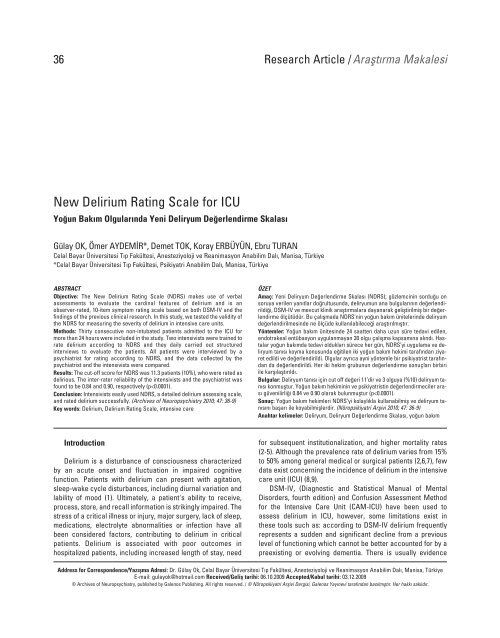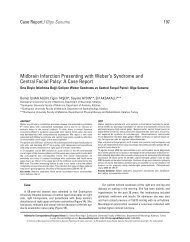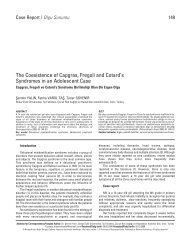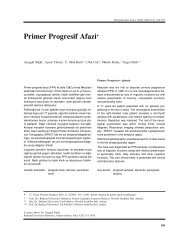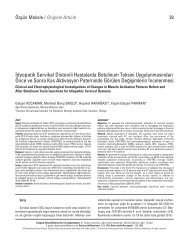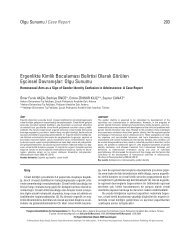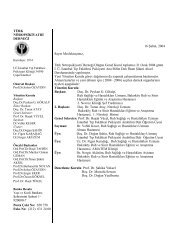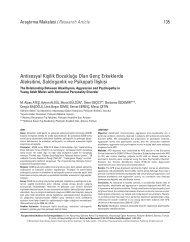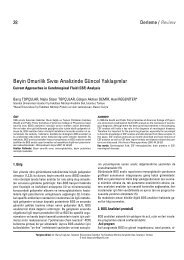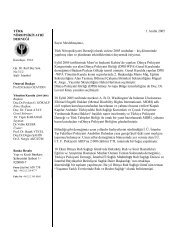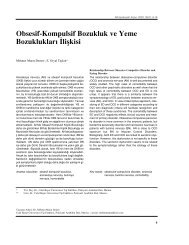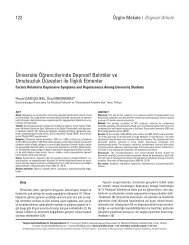New Delirium Rating Scale for ICU - Nöropsikiyatri ArÅivi Dergisi
New Delirium Rating Scale for ICU - Nöropsikiyatri ArÅivi Dergisi
New Delirium Rating Scale for ICU - Nöropsikiyatri ArÅivi Dergisi
You also want an ePaper? Increase the reach of your titles
YUMPU automatically turns print PDFs into web optimized ePapers that Google loves.
36<br />
Research Article /Araflt›rma Makalesi<br />
<strong>New</strong> <strong>Delirium</strong> <strong>Rating</strong> <strong>Scale</strong> <strong>for</strong> <strong>ICU</strong><br />
Yo¤un Bak›m Olgular›nda Yeni Deliryum De¤erlendirme Skalas›<br />
Gülay OK, Ömer AYDEM‹R*, Demet TOK, Koray ERBÜYÜN, Ebru TURAN<br />
Celal Bayar Üniversitesi T›p Fakültesi, Anesteziyoloji ve Reanimasyon Anabilim Dal›, Manisa, Türkiye<br />
*Celal Bayar Üniversitesi T›p Fakültesi, Psikiyatri Anabilim Dal›, Manisa, Türkiye<br />
ABSTRACT<br />
Objective: The <strong>New</strong> <strong>Delirium</strong> <strong>Rating</strong> <strong>Scale</strong> (NDRS) makes use of verbal<br />
assessments to evaluate the cardinal features of delirium and is an<br />
observer-rated, 10-item symptom rating scale based on both DSM-IV and the<br />
findings of the previous clinical research. In this study, we tested the validity of<br />
the NDRS <strong>for</strong> measuring the severity of delirium in intensive care units.<br />
Methods: Thirty consecutive non-intubated patients admitted to the <strong>ICU</strong> <strong>for</strong><br />
more than 24 hours were included in the study. Two intensivists were trained to<br />
rate delirium according to NDRS and they daily carried out structured<br />
interviews to evaluate the patients. All patients were interviewed by a<br />
psychiatrist <strong>for</strong> rating according to NDRS, and the data collected by the<br />
psychiatrist and the intensivists were compared.<br />
Results: The cut-off score <strong>for</strong> NDRS was 11.3 patients (10%), who were rated as<br />
delirious. The inter-rater reliability of the intensivists and the psychiatrist was<br />
found to be 0.84 and 0.90, respectively (p
Archives of Neuropsychiatry 2010; 47: 36-9<br />
Nöropsikiyatri Arflivi 2010; 47: 36-9<br />
Ok et al.<br />
<strong>New</strong> <strong>Delirium</strong> <strong>Rating</strong> <strong>Scale</strong> <strong>for</strong> <strong>ICU</strong> 37<br />
from the history, physical examination, or laboratory tests that<br />
the delirium is a direct physiological consequence of a general<br />
medical condition, substance intoxication or withdrawal, use of<br />
a medication, toxin exposure, or a combination of these factors<br />
(10). CAM-<strong>ICU</strong> also has some limitations in evaluating<br />
sleep-wake cycle and diurnal mood variations (11). Some<br />
standard delirium assessment methods require special<br />
psychiatric training that constitutes another objection <strong>for</strong> their<br />
repetitive implementations (12).<br />
The <strong>New</strong> <strong>Delirium</strong> <strong>Rating</strong> <strong>Scale</strong> (NDRS) has been developed<br />
by Aydemir and his colleagues <strong>for</strong> intensive care unit physicians<br />
working in the <strong>ICU</strong> (13). The NRDS makes use of verbal<br />
assessments to evaluate the cardinal features of delirium<br />
(i.e. acute or fluctuating onset, inattention, disorganized<br />
thinking and altered level of consciousness) and it is a 10-item,<br />
observer-rated scale based both on DSM-IV and on symptoms<br />
drawn from previous clinical research. In this study, we tested<br />
the validity of the NDRS <strong>for</strong> measuring the severity of delirium.<br />
Methods<br />
The study was carried out in a ten-bed medical/surgical <strong>ICU</strong><br />
of a university hospital. Thirty consecutive non-intubated<br />
patients admitted to the <strong>ICU</strong> <strong>for</strong> more than 24 hours during a 6<br />
month-period were included in the study. Medical history,<br />
selected laboratory values, drugs received, and factors that<br />
may influence patients’ psychological and emotional well-being<br />
were recorded and patients who use sedative agents were<br />
excluded. Two intensivists were trained to rate delirium<br />
according to NDRS (Table 1) and they carried out daily structured<br />
interviews lasting approximately 10 minutes with the patients<br />
from admission until <strong>ICU</strong> discharge. All patients were interviewed<br />
by a psychiatrist <strong>for</strong> rating NDRS, and the psychiatrist confirmed<br />
the diagnosis of delirium. For inter-rater reliability, intensivists<br />
rated all patients with the psychiatrist concurrently.<br />
NDRS is a ten-item, observer-rated scale with probe<br />
questions. The main feature of the scale is that it contains<br />
psychotic symptoms beside cognitive symptoms. The validation<br />
of the NDRS was per<strong>for</strong>med in a hospital setting with patients<br />
with delirium (Aydemir Ö, Noyan A, Gülseren fi, Kayahan B,<br />
Bodur Z, Elbi H, Kültür S (1998) Development, reliability and<br />
validity of <strong>Delirium</strong> <strong>Rating</strong> <strong>Scale</strong>. Journal of Psychiatry<br />
Psychology Psychopharmacology 6: 21-27). In reliability<br />
studies, Cronbach’s alfa coefficient of NDRS was found to be<br />
0.8804 and item-total score correlation coefficients were<br />
between 0.8616 and 0.8819. For inter-rater reliability (three<br />
raters), the correlation coefficient was 0.9815 and it was<br />
statistically significant (p
38<br />
Ok et al.<br />
<strong>New</strong> <strong>Delirium</strong> <strong>Rating</strong> <strong>Scale</strong> <strong>for</strong> <strong>ICU</strong><br />
Archives of Neuropsychiatry 2010; 47: 36-9<br />
Nöropsikiyatri Arflivi 2010; 47: 36-9<br />
should be managed through a systematic approach (18).<br />
Generally, it is accepted that delirious symptoms represent<br />
signs of acute cerebral insufficiency. Despite the fact that<br />
delirium occurs in 15% to 40% of <strong>ICU</strong> patients (17), it seems that<br />
the per<strong>for</strong>mance of critical care physicians’ in diagnosing it<br />
remains poor; nearly two-thirds of these patients are not<br />
identified (2-9, 19-22).<br />
An essential principle in the psychiatric management of<br />
delirium is the identification and correction of the etiologic<br />
factors. Careful review of the patient’s medical history and<br />
interview of family members or others close to the patient may<br />
provide some direction. Appropriate laboratory and radiological<br />
investigations may be necessary to determine the underlying<br />
cause(s) of delirium (23). Simple and well-defined tools that can<br />
be used at the bedside without being too time-consuming are<br />
always needed by intensivists. Evaluation methods that have<br />
been validated in the <strong>ICU</strong> combine several clinical parameters<br />
and psychological measurements into a continuous scale<br />
score (8,10,24-26). These scores carry the risk of specificity<br />
lacking regarding some particular aspects of mental alterations.<br />
For research purposes, an algorithm aimed at detecting<br />
delirium has been recently developed (27), but bedside<br />
Table 1. <strong>New</strong> <strong>Delirium</strong> <strong>Rating</strong> <strong>Scale</strong> (NDRS)<br />
1) Psychomotor activity<br />
0. Normal<br />
1. Mild increase (agitation or restlessness) or decrease (mild retardation) in activity<br />
2. Moderate increase (intending to leave the ward, grasping the tubes, groping the bed) or decrease (per<strong>for</strong>ming activity on command) in activity<br />
3. Excessive increase (excitation deserving fixation) or decrease (not even per<strong>for</strong>ming activity on command) in activity<br />
2) Orientation<br />
0. Normal<br />
1. Disorientation <strong>for</strong> time, or place, or person<br />
2. Disorientation <strong>for</strong> time and place, or time and person, or place and person<br />
3. Disorientation <strong>for</strong> time, and place, and person (rate no answer due to confusion here)<br />
3) Attention<br />
0. Normal<br />
1. Difficulty in concentration (maintaining his/her attention by himself/herself)<br />
2. Moderate disturbance in attention, distractibility (maintaining his/her attention on command)<br />
3. Total disturbance in attention (not even maintaining his/her attention on command)<br />
4) Memory<br />
0. Normal<br />
1. Disturbance in immediate or recent memory<br />
2. Disturbance in immediate and recent memory<br />
3. Disturbance in immediate and recent and remote memory (rate no answer due to confusion here)<br />
5) Perception<br />
0. Normal<br />
1. Vivid dreams and/or nightmares<br />
2. Transient illusions and/or hallucinations<br />
3. Definite illusions and/or hallucinations (hallucinatory experience)<br />
6) Thinking<br />
0. Normal<br />
1. Partially disrupted thinking<br />
2. Totally disrupted thinking<br />
3. Incoherence<br />
7) Thought content<br />
0. Normal<br />
1. Overvalued thought (does not act consistently and knows that it is false)<br />
2. Drafts of delusion (sometimes acts consistently and can inquire that it is false)<br />
3. Delusion (acts consistently and cannot inquire that it is false) or delusional experience<br />
8) Sleep-wake cycle<br />
0. Normal<br />
1. Marked drowsiness daytime while being awake most of the night<br />
2. Sleeping daytime while being awake all of the night<br />
3. Almost not sleeping or always sleeping during both the day and the night<br />
9) Diurnal variation<br />
0. No fluctuation<br />
1. Occurence of symptoms during the night while normal during the day<br />
2. Occurence of symptoms continuously during the night and interruptedly during the day<br />
3. Occurence of symptoms both during the day and the night fluctuatingly<br />
10) Lability of mood<br />
0. No fluctuation<br />
1. Alteration or change in mood over the course of hours<br />
2. Alteration or change in mood over the course of minutes (mood changes which are inappropiate to situation, including fear, anger or tearfulness)<br />
3. Severe disinhibiton of emotions (temper outbursts, uncontrolled laughter or crying)
Archives of Neuropsychiatry 2010; 47: 36-9<br />
Nöropsikiyatri Arflivi 2010; 47: 36-9<br />
Ok et al.<br />
<strong>New</strong> <strong>Delirium</strong> <strong>Rating</strong> <strong>Scale</strong> <strong>for</strong> <strong>ICU</strong> 39<br />
Table 2. Demographic data and patients’ diseases<br />
Patients (n:30)<br />
Age, mean (SD) 48.6±17.24<br />
Gender (Male:Female) 24: 6<br />
Blood urine nitrogen (BUN), (mg/dl) (SD) 32.4±3.5<br />
Creatinin, (mg/dl) (SD) 0.8±0.2<br />
APACHE II score, mean (SD) 7.6±2.3<br />
Multiple trauma 14<br />
Abdominal surgery 12<br />
Gastrointestinal bleeding 4<br />
evaluation of delirium by the intensivist carries some difficulties.<br />
Trzepacz’s <strong>Delirium</strong> <strong>Rating</strong> scale evaluates attention, memory,<br />
orientation and cognitive abilities in one clause (19), there<strong>for</strong>e,<br />
assessing the symptoms through this scale should be complex<br />
<strong>for</strong> the intensivists, since they are not familiar with psychotic<br />
symptoms. On the other hand, NDRS is a well-structured scale<br />
that questions the cognitive abilities individually and<br />
intensivists could assess the patients easily by using these<br />
clear definitions and assessment of sleep-wake cycle, diurnal<br />
variation and lability of mood are the superiority of this tool over<br />
CAM-<strong>ICU</strong>.<br />
In conclusion, intensivists used NDRS, a detailed delirium<br />
assessing scale, easily and rated delirium so successfully that<br />
the inter-rater reliability <strong>for</strong> rating delirium between the<br />
intensivist and the psychiatrist was comparable.<br />
References<br />
1. Tucker GJ. The Diagnosis of <strong>Delirium</strong> and DSM-IV. Dement Geriatr<br />
Cogn Disord 1999; 10:359-63. [Abstract] / [PDF]<br />
2. Francis J, Martin D, Kapoor WN. A prospective study of delirium in<br />
hospitalized elderly. JAMA 1990; 263:1097-101. [Abstract] / [PDF]<br />
3. Inouye SK, Schlesinger MJ et al. <strong>Delirium</strong>: a symptom of how<br />
hospital care is failing older persons and a window to improve<br />
quality of hospital care. Am J Med 1999; 106:565-73. [Abstract] / [Full<br />
Text] / [PDF]<br />
4. O'Keeffe S, Lavan J. The prognostic significance of delirium in older<br />
hospital patients. J Am Geriatr Soc 1997; 45:174-8. [Abstract] / [Full<br />
Text]<br />
5. Metitieri T, Bianchetti A, Trabucchi M. <strong>Delirium</strong> as a predictor of<br />
survival in older patients with advanced cancer. Arch Intern Med<br />
2000; 160:2866-7. [Abstract] / [Full Text] / [PDF]<br />
6. Inouye SK, Bogardus ST, Charpentier PA et al. A multicomponent intervention<br />
to prevent delirium in hospitalized older patients. N Engl J<br />
Med 1999; 340:669-76. [Abstract] / [Full Text] / [PDF]<br />
7. Levkoff SE, Evans DA, Liptzin B et al. <strong>Delirium</strong>: the occurrence and<br />
persistence of symptoms among elderly hospitalized patients. Arch<br />
Intern Med 1992; 152:334-40. [Abstract] / [PDF]<br />
8. Bergeron N, Dubois MJ, Dumont M et al. Intensive Care <strong>Delirium</strong><br />
Screening Checklist: evaluation of a new screening tool. Intensive<br />
Care Med 2001; 27:859-64. [Abstract] / [Full Text] / [PDF]<br />
9. Ely EW, Siegel MD, Inouye S. <strong>Delirium</strong> in the intensive care unit: an<br />
under-recognized syndrome of organ dysfunction. Semin Respir Crit<br />
Care Med 2001; 22:115-26. [Abstract] / [Full Text] / [PDF]<br />
10. Ely E, Margolin R, May L et al. Evaluation of delirium in critically ill<br />
patients: validation of the Confusion Assessment Method <strong>for</strong> the<br />
Intensive Care Unit (CAM-<strong>ICU</strong>). Crit Care Med 2001; 29:1370-9.<br />
[Abstract]<br />
11. Bergeron N, Skrobik Y, Dubois MJ. <strong>Delirium</strong> in critically ill patients.<br />
Critical Care 2002; 6:181-2. [Abstract] / [Full Text] / [PDF]<br />
12. Hart RP, Levenson JL, Sessler CN et al. Validation of a cognitive test<br />
<strong>for</strong> delirium in medical <strong>ICU</strong> patients. Psychosomatics 1996; 37:533-46.<br />
[Abstract] / [PDF]<br />
13. Aydemir Ö, Noyan A, Gülseren S ve ark. Deliryum derecelendirme ölçe-<br />
¤inin gelifltirilmesi, güvenirli¤i ve geçerli¤i. 3 P <strong>Dergisi</strong> 1998; 6:21-7.<br />
14. Knaus WA, Wagner DP, Draper EA et al. APACHE II: a severity of<br />
disease classification system. Crit Care Med 1985; 13:818-29.<br />
[Abstract]<br />
15. Trzepacz PT. The <strong>Delirium</strong> <strong>Rating</strong> <strong>Scale</strong> (Its Use In Consultation-Liaison<br />
Research). Psychosomatics 1999; 40:193-204. [Abstract] / [Full Text] / [PDF]<br />
16. Ely E, Shintani A, Truman B et al. <strong>Delirium</strong> as a predictor of mortality<br />
in mechanically ventilated patients in the intensive care unit. JAMA<br />
2004; 291:1753-62. [Abstract] / [Full Text] / [PDF]<br />
17. Chevrolet JC, Jolliet P. Clinical review: Agitation and delirium in the<br />
critically ill significance and management. Critical Care 2007; 11:214.<br />
[Abstract] / [Full Text] / [PDF]<br />
18. Siegel M. Management of agitation in the intensive care unit.Clin<br />
Chest Med 2003; 24:713-25. [Abstract] / [Full Text] / [PDF]<br />
19. Trzepacz PT, Dew MA. Further analyses of the delirium rating scale.<br />
Gen Hosp Psychiatry 1995; 17:75-9. [Abstract] / [PDF]<br />
20. Pompei P, Foreman M, Cassel CK et al. Detecting delirium among<br />
hospitalized older patients. Arch Intern Med 1995; 155:301-7.<br />
[Abstract] / [PDF]<br />
21. Marcantonio ER, Juarez G, Goldman L et al. The relationship of<br />
postoperative delirium with psychoactive medications. JAMA 1994;<br />
272:1518-22. [Abstract] / [PDF]<br />
22. Pandharipande P, Jackson J, Ely E. <strong>Delirium</strong>: acute cognitive<br />
dysfunction in the critically ill. Curr Opin Crit Care 2005; 11:360-8.<br />
[Abstract]<br />
23. American Psychiatric Association (APA) Practice Guidelines <strong>for</strong> the<br />
Treatment Psychiatric Disorders. Compendium 2006, p. 79.<br />
24. De Jonghe B, Cook D, Griffith R et al. Adaptation to the intensive care<br />
environment (ATICE): development and validation of a new sedation<br />
assessment instrument. Crit Care Med 2003; 31:2344-54. [Abstract]<br />
25. Devlin J, Boleski G, Mlynarek M et al. Motor activity assessment scale:<br />
a valid and reliable sedation scale <strong>for</strong> use with mechanical ventilated<br />
patients in an adult surgical intensive care unit. Crit Care Med<br />
1999; 27:1271-5. [Abstract]<br />
26. Riker R, Picard J, Fraser G. Prospective evaluation of the Sedation-<br />
Agitation <strong>Scale</strong> (SAS) <strong>for</strong> adult critically ill patients. CritCare Med<br />
1999; 27:1325-9. [Abstract]<br />
27. Pisani M, Araujo K, Van Ness P et al. A research algorithm to improve<br />
detection of delirium in the intensive care unit. Crit Care 2006;<br />
10:R121-9. [Abstract] / [Full Text] / [PDF]


